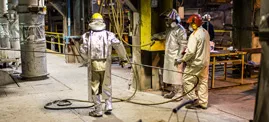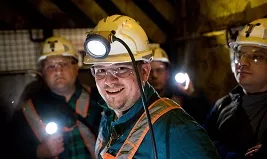The mining activities carried out by KGHM's underground mines cause a disturbance of the rock mass's equilibrium, as a result of which there are impacts on the surface:
- direct, continuous (related to the movement of the rock mass into the post-mining void) in the form of deformation of the terrain surface, manifested as depressions of the terrain (subsidence basins) with a range extending beyond the mining contours, affecting buildings and water and soil relations. The measure of the mining area hazard due to deformation influences is the mining area category which is described by deformation indicators. The basic indicators are: subsidence (w), horizontal strain (ε), slope (T) , radius of curvature (R).
- dynamic impacts in the form of parasyseismic tremors affecting land development structures and people. The impact of mining tremors on buildings and linear underground infrastructure is assessed using the Mining Intensity Scale (GSI-2004/18) The scale includes four grades (from 0 to 3), for which the influence of tremors on buildings and underground infrastructure is described, as well as the intensity of vibrations felt by people and inconvenience of using the buildings. The forecasted range of influence in individual intensity levels in the scale GSI-2004/18 is determined in subsequent Mine Operation Plans. The measure of the risk of the mining area being affected by dynamic impacts in relation to the newly erected objects is the assignment of a specific seismic zone, LGOM, to the given area. The zone is described by the parameters of ground vibrations which may occur at the maximum in the given area: acceleration (PGAH10) and velocity (PGVHmax) as well as design ground acceleration ap, which should be taken into account in calculations when designing buildings in the given area.
- indirect impacts (related to the drainage of tertiary layers) in the form of large-area subsidence (large-area drainage basin). These impacts are described by a single indicator, the lowering of the mining area due to dewatering. The large-scale drainage basin has a gentle profile, hence the surface deformation indicators are insignificant. In areas where these influences do not combine with land subsidence due to mining, they do not cause mining damage to land surface development and mining damage of a hydrogeological nature.
The undertaken measures are as follows:
- covering the costs of building protections in buildings erected in mining areas exposed to the harmful effects of deformations and mining tremors,
- modernisation of buildings which are not resistant to the harmful effects of the planned exploitation,
- covering the costs of land reclamation in areas exposed to flooding and waterlogging as a result of mining impacts,
- repair of buildings damaged by the effects of mining exploitation or reimbursement of the costs of such repairs.
The responsibility of the mining entrepreneur in Poland for damage caused by operation of the mining plant (mining damage) and for preventing damage is regulated by the following legal provisions:
- Act of 23 April 1964, Civil Code,
- Act of 9 June 2011, Geological and Mining Law.
Procedure in matters related to the protection of objects in mining areas
All matters related to:
- issuing information on the impacts of mining exploitation (IWEG) to be used when securing buildings against mining impacts,
- agreeing building designs within the scope of applied safeguards against mining impacts,
- reimbursing the costs of securing buildings,
- reporting mining damage,
should be reported to the mine, in the mining area of which the property concerned is located.
Map showing the territorial jurisdiction of individual KGHM mines with respect to the handling of matters related to the protection of buildings in mining areas.
Issuing information on the impacts of mining exploitation (IWEG) for investment projects
Information on the impacts of mining exploitation is provided by the appropriate KGHM mine at the written request of the person undertaking an investment project in the mining areas of KGHM.
The written application should include:
- applicant's and investor's data: name and surname or company name, address and contact telephone number,
- type of investment,
- location of the investment: address or no. of the building plot,
- a section of a map with marked location of the investment in the case of linear investments.
The information provided by the mine includes:
- description of current and projected impact of continuous deformation from mining exploitation,
- description of forecasted dynamic impacts,
- recommendations for designing preventive protection for buildings,
- information on the course of arrangements concerning construction prophylactic protection,
- information on water passages.
Reimbursement of costs of securing buildings against the effects of mining exploitation
Reimbursement of costs of securing a building against the consequences of mining exploitation covers the justified costs of the securing works carried out. The basis for payment of appropriate compensation is a settlement concluded between the investor and KGHM, on condition that the construction work carried out is properly documented.
It is recommended that the design solutions be agreed with the Mine Damage Department of KGHM Polska Miedź S.A. This agreement will be the basis for determining the material scope and financial dimension of compensation due for the investor for the designed preventive protection.
Requirements with respect to documents to be provided by investors:
- investor's application for reimbursement with contact address and telephone number, bank account number, type and number of identity card (by whom issued), PESEL number,
- photocopy of building permit,
- project documentation to be inspected,
- construction log to be inspected, with an entry by the mine representative concerning preventive measures,
- determination/statement of the amount of justified claims for costs incurred for the execution of works related to preventive protection of the facility against the impact of mining exploitation,
- contract and invoice for execution of works in the case of commissioned works,
- for legal persons, a statement on the status of an active VAT taxpayer, a document confirming business activity (KRS, NIP, REGON).
It is recommended that prior to the commencement of construction works, the investorshould notify the entrepreneur of this fact and enable him to participate in the acceptance of works related to the execution of protection against the effects of mining exploitation.
Reporting mining damage
Proceedings for the remedy of damage are initiated at the written request of the injured party, submitted to the competent KGHM mine.
In emergency situations, when the health, life or property of an injured party is endangered and immediate remedial action is required, the report can be made by telephone at:
Mine Damage Departments from 7:00 am to 3:00 pm
- Lubin Mine 76 7482 403, 335
- Polkowice-Sieroszowice Mine 76 7484 230, 232
- Rudna Mine 76 7485 708, 76 748 66 79
At the Mine Dispatcher's Office between 3 p.m. and 7 a.m.
- Lubin Mine 76 7482 222
- Polkowice-Sieroszowice Mine 76 7484 111
- Rudna Mine 767485 200
An application for damage to crops and sowings must be submitted during the growing season of the crop, before the date of its planned harvest. An application submitted in any other period must be supplemented by documents confirming: occurrence of the damage, type of crop and its area in the period to which the application refers (these conditions do not apply to a request for compensation for the inability to use the land for its intended purpose).
In order to ascertain the causal link between the damage and the mining plant operation, an inspection of the damage is carried out. KGHM proposes a date for the inspection.
An employee of the mine inspects the damage on behalf of the company (in the presence of the applicant). A protocol is drawn up of the inspection, in which all observed damages are described. The applicant is entitled to receive a copy of the report.
The mine, after examining the reasonableness of the application to repair the damage, is obliged to notify the applicant in writing of the result of its examination within 30 calendar days from the date of its receipt.
If, following an analysis of the damage (documented during the inspection) and the parameters of the effects of mining exploitation, a cause-and-effect relationship is established between the damage and the operation of the mining plant, the mine approaches the applicant with a proposal to repair the damage. If such a relationship does not exist, the applicant's claim is dismissed.
The legal grounds for performance of damage repair is the agreement between the injured party and the entrepreneur - this condition does not apply to emergency situations.
In cases of dispute, the settlement is replaced by a final judgement of a common court.
The repair of damage consisting in restoring the previous state of affairs may be performed by the entrepreneur or by the injured party. In the first case, the KGHM mine entrusts construction work to specialist external companies. In the second case, with the consent of the mine, the injured party may carry out the repair work himself, at the expense of the mine, under the agreed conditions. If restoration is not possible or if it entails costs inadequate to the damage, the injured party is entitled to compensation.





